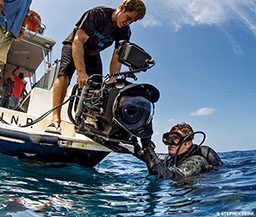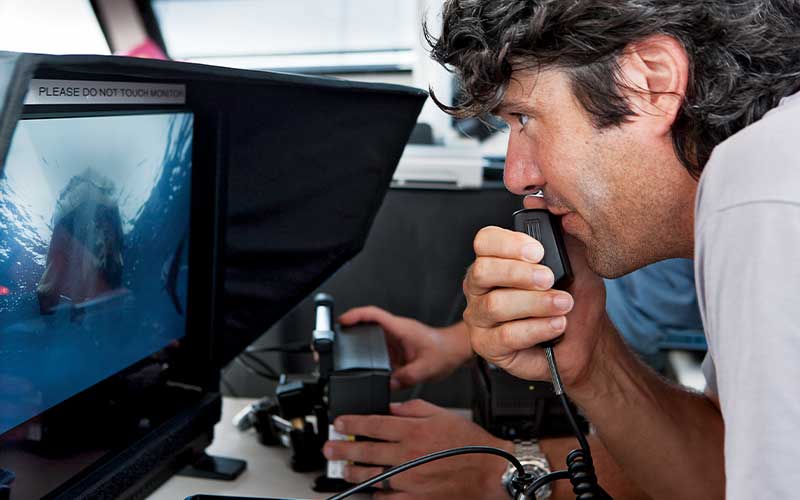When I last spoke to J.C. Chandor, the writer and director of All is Lost, he had just returned from the film’s premiere at Cannes and was basking in the afterglow of an enthusiastic reception there.
“This is a film that needs to be seen on the big screen,” Chandor said. “The audience needs to be able to get their minds in the place of the main character. At Cannes we had a theater with 2,500 people all leaning forward in their seats. Sound — as well as visuals — is a huge part of this film, and the audience definitely got it. We had incredible cinematography — so good that things we shot in reality were assumed to be computer-generated special effects. But in the end it was the talent and dedication of Robert Redford that dominated. While this is an experiential action movie, it is also quite existential.”
The premise is one that anyone who has ever lived aboard a boat at sea can relate to: Sound asleep in the dead of night on a passage in the Indian Ocean, a massive thud reverberates through the hull. The sailor is Robert Redford, and he is alone on his fairly modest 39-foot sailboat. The early light of dawn reveals that the fateful bump in the night was a partially submerged shipping container knocking a gaping hole into the side of the boat. The sailor’s calls for help on the VHF radio are about the only dialogue in the whole movie, and the response to them is only static. Despite his heroic efforts to patch the hull, the sailor is drawn inexorably into the path of a violent storm. Soon he succumbs to the inevitability that his boat will sink, and his new reality is life adrift in a raft.

Making a film entirely in and around the water was a huge challenge for Chandor, whose debut feature film, the Oscar-nominated Margin Call, featured an ensemble cast and extensive dialogue. This time it was just Redford and the harsh realities of survival at sea.
“It’s a very big challenge being alone, with no crutch, no dialogue, no words,” Redford said. “It’s a challenge that attracted me a lot as an actor. I believe in the role of silence in film, and in life, because we often talk far too much. Silence allows you to really live your role and forces you to totally trust the director.”
Chandor characterized the film as a realistic portrayal of “Our Man” — the only name Redford’s character has in the script — coming to grips with his own mortality. He didn’t want this to be a superhero film, but rather one about the particular things the man experiences in his days at sea that define whether he lives or dies. “Average people in extraordinary circumstances” is how Chandor described it. There is a scene in which the man stands in chest-deep water in his sinking ship and shaves his face before a mirror. The scene is both mundane and extraordinary in that the opportunity may never again exist for Our Man. Such sublime moments are the hallmarks of this film, which Entertainment Weekly called “scarier than anything in The Perfect Storm.“
Chandor was never a Wall Street trader before making Margin Call, but he was a sailor before he made All is Lost. He had experienced ocean-induced fear, too. He was once caught in a wicked storm during a yacht delivery to Bermuda — a psychological shadow that came out of hiding for this script. “Script” might be too grand a description of the project’s origin though; the spare, 32-page treatment was more like a narrative or an essay. I asked Chandor how he managed to bring such a major talent on board for that kind of project. In the past 15 years Robert Redford hadn’t acted in a single picture he hadn’t directed. Why was Chandor’s film so special?

“I was at a seminar for filmmakers at Sundance, and Robert Redford was speaking,” Chandor said. “Margin Call had done very well at the festival, but I hadn’t actually met Redford yet. I was sitting in the back of the room listening to this really iconic voice — one we’d all grown up with from so many movies. He was describing his 1972 film, Jeremiah Johnson, in the context of a man who had the choice to give up or continue in the face of daunting odds. He goes on because that’s all he can do. Some might have given up, but he never does. That’s the spirit I envisioned for Our Man.” So he sent Redford the treatment.
It is perhaps surprising that Redford isn’t inundated with movie pitches from aspiring filmmakers. “There’s something ironic in that; all these years after starting Sundance and starting the film festival, none of the filmmakers I supported ever hired me,” Redford said with the smile we’ve all seen so often. “They never offered me a part until J.C.” Four days after receiving the script, Redford invited Chandor to a meeting at his office in Los Angeles. Ten minutes into the meeting Redford slapped his knee and said, “I just wanted to make sure you aren’t totally crazy. Let’s do it!”

At that point, the daunting task of making this film set in. Sinking a boat repeatedly is not a project for the open ocean, so a water set had to be found. The perfect set was at Baja Studios in Rosarito, Mexico. It was built by James Cameron to shoot the marine effects for Titanic, but the studio had gone largely unused for years because of security concerns in an area rife with drug warfare. The Mexican government eventually intervened, security was provided, and the All Is Lost crew got access to three giant water tanks. Among them was the world’s largest infinity-edge tank, which sits right on the ocean shore and is the size of three football fields.
Pete Zuccarini, the film’s director of underwater cinematography, said it was a blessing that Redford had such terrific water skills: “He could be in the water eight hours a day and then go swimming for fun when he went home at night.” This from a man who was 75 years old at the time the film was made, which wouldn’t necessarily be relevant except that Our Man’s survival depended on his ability to overcome the hazards of nature as well as his own frailties.
Special effects supervisor Brendon O’Dell used a massive dump tank to simulate the violent movements of a sinking ship. Rigging and hydraulic cylinders were employed to suck the boat downward and move it side to side. Much of the movie was filmed in tanks, but some scenes were shot in the open ocean, including scenes of the sailboat at sea in the Sea of Cortez and shots with sharks in the Bahamas.

Zuccarini recalled conversations with Chandor about the shark segment, and they briefly considered going to Guadalupe Island to shoot great whites for the scenes where sharks surround the raft and disrupt the survival fishing done by Our Man. But Chandor made the call that this was not supposed to be a monster movie — the sharks were meant to be a nuisance and somewhat of a hazard; too much shark would overpower the subtleties of the performance.
Redford performed most of the stunts himself, a fact the producers found both inspiring and unnerving. After all, he is the only actor in the whole movie, and if he were to get hurt doing take after take of jumping from the sailboat into the life raft or being pulled laterally for 50 feet in a breath-hold stunt, the production would be in serious jeopardy. Regarding Redford, Zuccarini said, “He was the consummate professional, swimming an hour a day just to stay fit. To be honest, he’s an inspiration for any working man. He’s a movie star digging in with physical labor, giving a really convincing physical performance. He was dragged, rolled over and took more than a few bumps and bruises. The man was all in for this project.”
© Alert Diver — Q4 Fall 2013